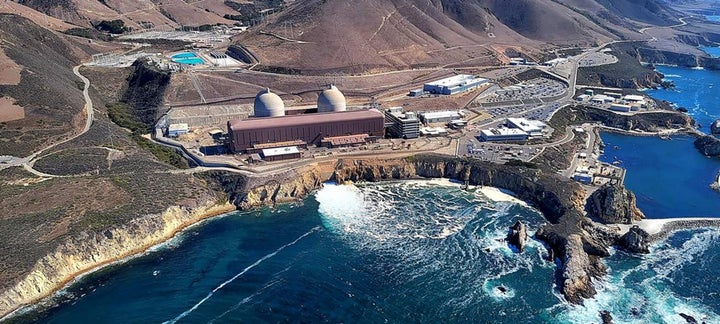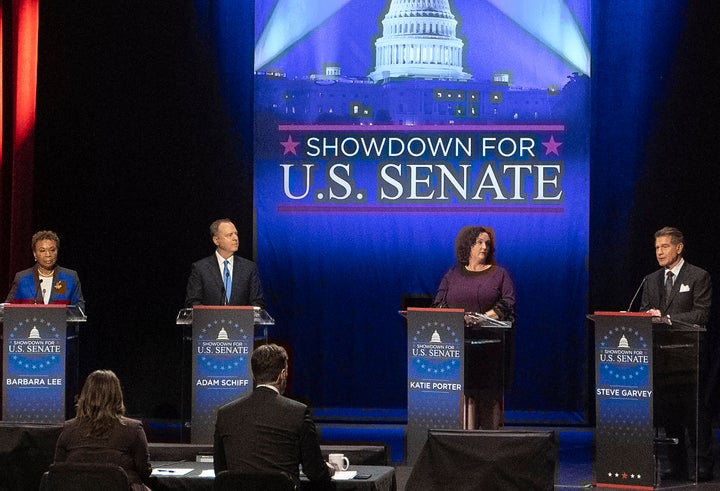All three Democrats vying to be California’s next U.S. senator expressed support for closing the state’s last nuclear power station at this week’s final televised debate before next month’s primary election.
Rep. Adam Schiff, the current front-runner in the nonpartisan primary to replace the late Sen. Dianne Feinstein, said he supports nuclear energy but wants to see the Diablo Canyon Power Plant closed by the end of the decade.
Fellow Democratic Reps. Katie Porter and Barbara Lee ― who are trailing in third and fourth place, respectively ― took hard-line stances against atomic power during Tuesday’s debate. Republican Steve Garvey, the second-place contender in the latest poll, made a vague statement of support for atomic energy before launching into a meandering diatribe about fossil fuels.
The nation’s largest state once supplied its growing population’s energy needs with three nuclear power stations. (A fourth had shut down in the 1970s before the others were built). But an anti-nuclear movement grew throughout the 1960s, fueled in part by misinformation conflating atomic weapons with fission energy, sincere ideological desires to limit economic development, and Hollywood movies that sensationalized and exaggerated the safety risks associated with modern reactors. Despite the increasing need for the steady carbon-free electricity reactors generated as climate change worsened, the state prioritized shutting down nuclear plants over fossil fuel stations.
Since the San Onofre nuclear plant in San Diego shut down in 2013, leaving only Diablo Canyon, electricity rates skyrocketed in California. In 2016, state officials pressured Diablo Canyon’s owner, the utility giant Pacific Gas & Electric, into an agreement to shut down the state’s last nuclear plant in less than a decade. A year later, the California Public Utility Commission quietly removed the promise of “reasonable rates” from its mission statement.
At nearly 30 cents per kilowatt-hour, California’s electricity rates are among the highest in the country, eclipsing the national average last year by more than double. A sampling of posts in the San Francisco area on the neighborhood forum app Nextdoor shows residents pleading for help after receiving $175 electric bills for tiny one-bedroom apartments.
“Something is wrong!” the post reads. “I called [PG&E], they said that was normal.”

Diablo Canyon was slated to close no later than 2025.
Nestled along the mountainous coast outside San Luis Obispo, Diablo Canyon generates nearly 10% of the Golden State’s electricity and helps stabilize an aging grid facing new demands from extreme weather, electric cars, and an influx of solar and wind energy that fluctuates with the weather.
As blackouts mounted and electricity rates soared, Gov. Gavin Newsom (D) sought to reverse the shutdown. In 2022, state lawmakers passed legislation postponing Diablo Canyon’s closure until 2030. Even activists like Jane Fonda, who campaigned for years to end nuclear power, supported the extension.
In December, federal regulators accepted Diablo Canyon’s license renewal. Last month, the Biden administration unveiled a $1.1 billion aid package to keep the plant.
Nonprofits like the Environmental Working Group, which previously promoted debunked studies linking vaccines to autism, have called keeping the plant open “dangerous.”
At this week’s debate broadcast on NBC’s Los Angeles affiliate, moderator Conan Nolan teed up the four candidates with a question that rattled off the benefits of nuclear power, which he noted was supported by the president, the governor and scientists calling for a phase out of fossil fuels.
“It runs rain or shine. It’s not weather dependent. It doesn’t contribute to global warming. It takes up a fraction of the space of the massive wind and solar farms you’ve advocated,” said Nolan, NBC4’s chief political reporter. “Do you support the extension of Diablo Canyon and does nuclear have a role in fighting climate change?”

Porter answered first.
“Diablo Canyon needs to be safely decommissioned,” she said. “I would close Diablo Canyon.”
Schiff said “nuclear energy has a role to play in our energy portfolio,” at least on the national level, but said he supports the current plan to shut down Diablo Canyon at the end of the decade.
“I support the governor’s plan to decommission the plant,” he said. “We’re going to need to move to renewable energy. We’re going to need to move to wind and solar.”
Lee, the progressive stalwart in fourth place, said she did not even support extending Diablo Canyon’s life by another five years.
“I don’t support nuclear power,” she said. “I fully support decommissioning.”
Garvey, a former professional baseball star, expressed support for nuclear energy generally, but trailed off on diatribe about the value of oil and gas, and said “the people will decide” which energy sources are best.
PG&E declined to comment directly on the candidates’ statements, but said that it’s following the state law directing the utility to renew Diablo Canyon’s license to “help ensure statewide electric reliability and minimize greenhouse gas emissions as California transitions to a clean energy future.”
“We remain focused on providing reliable, low-cost, emission-free energy to Californians, while safely operating the state’s largest clean energy producer,” the company said.
With California’s infrastructure already heaving under the effects of climate change, blackouts are becoming more common, cutting off anyone who can’t afford expensive batteries or generators from the primary resource needed for everything from communication and transportation to cooking and medicine.
“There’s going to be a lot of money to be made helping rich Californians become as insulated as possible from the effects of their own policy choices while moralizing to poor Californians that maybe they can’t just expect electricity in a time of climate crisis,” Mark Nelson, a nuclear engineer and co-founder of the consultancy Radiant Energy, told HuffPost.
With nearly half of Democratic voters nationwide in support of atomic energy, the debate, he said, showed that “Democrats still don’t take energy seriously enough to match their base’s shift on nuclear.”
“We’re still in this era where you can talk about climate knowing nothing about energy,” Nelson said. “It’s unacceptable.”
This story has been updated to include a comment from PG&E.
